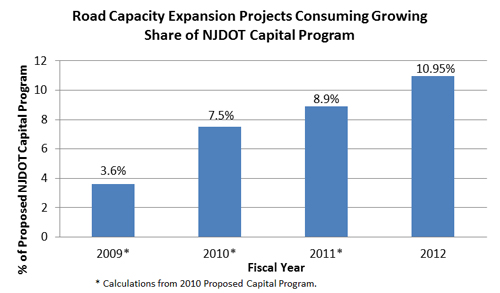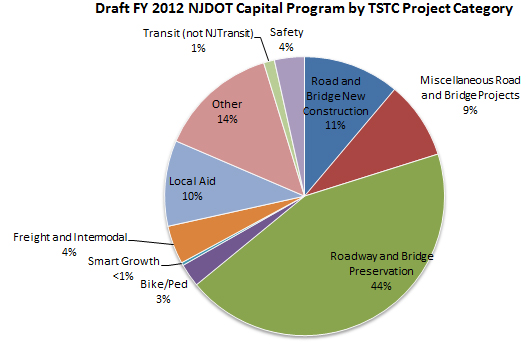[This post was modified on September 19, 2012]
A new analysis of the NJDOT’s proposed fiscal year 2012 capital program shows that maintenance and repair continue to make up the largest category of spending, but also finds a higher percentage of funds going to highway and bridge expansion than in any year in nearly a decade.
“The analysis makes us concerned the NJDOT is taking on too many new road widening projects that it cannot afford and moving away from smart transportation policies,” TSTC executive director Kate Slevin said in a release.
Last month, New Jersey released its draft 2012 capital program. The plan provides almost $3.5 billion in funding for the state’s road and transit systems, with approximately $2.3 billion going to NJ Department of Transportation and $1.164 billion set aside for New Jersey Transit. In a new report, A Bumpy Road Ahead?, TSTC closely analyzes the NJDOT portion of the capital program, comparing funding levels across project types, and examining trends in past spending priorities. Several themes emerged:
1. Road and bridge maintenance continue to make up the largest percentage of NJDOT’s capital program budget. The agency is dedicating nearly 44% of the fiscal year 2012 capital spending to rehabilitation, repair, resurfacing, and replacement projects. This compares favorably to previous years. In 2009, TSTC found that the agency dedicated 44% of its budget to maintenance and 36% in 2010. NJDOT must prioritize a “fix-it-first” strategy given the poor condition of the state’s existing infrastructure.
2. Spending on road capacity expansion projects makes up nearly 11% of the capital program, the largest percentage in nearly a decade, threatening to undermine the state’s “fix-it-first” goals. Increasing spending on capacity expansions is a troubling, but growing trend in recent NJDOT capital programs:

3. Funding for signature smart growth programs has been reduced or eliminated. Cuts to these programs are likely to affect the smart growth efforts of municipalities across the state. The 2012 capital program defunds New Jersey’s Transit Village program, which has helped towns promote sustainable, transit-oriented development statewide. In 2011, the program received $1 million, and in previous years, the program has been allocated as much as $3 million. Also defunded is the Centers of Place program, which has previously provided competitive grants for downtown improvements such as streetscaping, lighting, wayfinding, and pedestrian safety projects. Lastly, funding for the NJ Future in Transportation program, which seeks to build more sustainable communities with state transportation projects, is lacking and a new round of projects has not been announced.
4. Funding for bicycle and pedestrian projects shows NJDOT’s commitment to pedestrian and bicyclist safety. With 2.74% of the proposed capital program going to active transportation, NJDOT remains a national leader in spending on this area. Some of the 2012 projects include the Riverbank Park Bike Trail in Hudson County, the East Coast Greenway in Middlesex and Union Counties, the New Brunswick Bikeway, and River Road improvements in Camden. In addition, a number of roadway and bridge projects have bicycle and pedestrian additions, such as the Route 50 Tuckahoe River Bridge. However, funding for Safe Streets to Transit, which has helped towns provide safer access to rail and bus hubs, has been decreased from the intended $1 million to $500,000. Sustained funding is critical if the state hopes to continue to reduce bicyclist and pedestrian deaths.
The report offers the following recommendations for the Governor, State Legislature and NJDOT:
- Recommit to the fix-it-first policy mandated in 2000 to reduce the backlog of deficit roads and bridges by half as the state approves the Transportation Capital Program this year.
- Take a hard look at proposed road expansion projects and call off projects that will not offer sustainable congestion relief. If the state could not afford the Access to the Region’s Core tunnel project, it cannot afford paying for road expansion projects that do little to reduce traffic congestion.
- Create a consistent fix-it-first policy among all state transportation agencies, including NJDOT and the New Jersey Turnpike Authority.
- Restore and increase funding for the state’s smart growth programs to ensure continued progress on these initiatives. Dedicate at least $1 million annually to NJ Transit Village program and the Centers of Place program. Launch a new round of NJ FIT projects that help towns plan for the future.
- Continue to fund bicycle and pedestrian projects, targeting financial support to places with the highest number of pedestrian and bicyclist injuries and deaths. Restore funding to the Safe Routes to Transit program to at least $1 million annually.
- Use money previously earmarked for Access to the Region’s Core for its intended purpose of improving the cross-Hudson commute.
- Find new sources of revenue. The proposed capital program relies on $1.8 billion in transfers from the state’s General Fund over five years — revenues that presently do not exist.
The State Legislature must now review, change, and approve the capital plan. The final decisions will be reflected in the state’s annual Appropriation Act, which takes effect on July 1.
Graphs: TSTC.


What about NJDOT request to eliminate funding for bike/ped improvements along Rt 7, one of the few potential bike/ped routes between Newark and Jersey City and a long planned route for the East Coast Greenway??
[…] in an interview with NJ 101.5 discussing the Tri-State Transportation Campaign’s recent analysis of the DOT capital plan. He likened distributing the $1 million grant pool to “trying to […]
[…] top of a 101.5 story recapping Tri-State’s annual analysis of NJDOT’s capital plan. That analysis found that in fiscal year 2012, the state would continue to spend the largest portion of its plan […]
[…] better job than most states of funding pedestrian and cycling projects. But NJDOT is also spending significantly more on road expansion than it has in the recent past. If NJ instead brought its commitment to transit […]
[…] 11.15% in the draft program. That draft program would have committed the department to spending the highest percentage of funds on new road capacity in nearly a decade. This further increase from the draft program is […]
[…] which acknowledges NJDOT’s financial challenges, has criticized the agency for its overspending on highway expansion and underfunding smart growth and complete streets initiatives. So it’s not that we want to […]
[…] 2004. Since 2009, funding for new road capacity projects has increased by almost 400%—a troubling trend highlighted by the Campaign in previous […]